This program calculates:
- the mass of our Galaxy as a function of visible matter (Radius Visible Galaxy), the radius of the bulge (R bulge) and the speed of the Sun (SP velocity)
- the rotation speed of our Galaxy as a function of the distance from the center of our Galaxy. The maximum distance is 70000 lightyears.
Operation - part 1
When the program starts you get the following display:
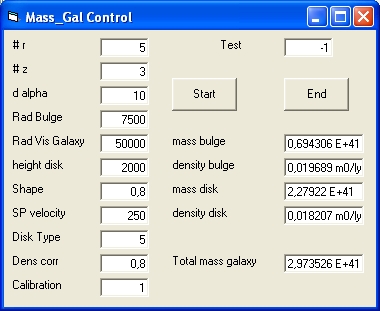
|
- # r Defines the number of segments in the r direction. Standard value is 5.
- # z Defines the number of segments in the z direction. Standard value is 3.
- delta alpha Defines the delta angle alpha. Standard value is 10 degrees.
- Radius BulgeDefines the radius of the bulge. Standard value = 7500 light years
- Radius Visible galaxyDefines the radius of visible galaxy. Standard value = 60000 light years
- Radius Total galaxyDefines the radius of total galaxy. Standard value = 70000 light years
- height disk Defines the height of the disk at centre of Galaxy. Standard value is 2000 light years.
- shape disk Defines the height of the disk at distance of Radius Total galaxy. Shape = 1 means that the distance is equal height disk. Standard value = 0.1
- sp velocity Defines velocity setpoint for calibration at a distance of 25000 lightyears. Standard value is 250 km/sec.
- disk type Defines the disk type.
There are 4 disk types:- 1 = straight line. 2 = cosinus (0 - 90). 3 = cosinus (90 - 180). 4 = cosinus (0 - 180)
- The standard value is 3.
- disk Dens CorrectionDefines Disk Density Correction relative to bulge. Standard value is 0.6
- calibration Defines calibration condition. 1 = yes. 0 = No. Standard value is 1.
Operation - part 2 START and END command
Just press START in order to start the simulation.
When the simulation is finished modify the parameters and press START again or press END to finish.
Operation - part 3 TEST parameter
There are 9 standard tests included which have the values from 1 to 9.
In order to select a test change the parameter Test to the requested value and select START
- When the value -1 is entered the 4 disk types are displayed:
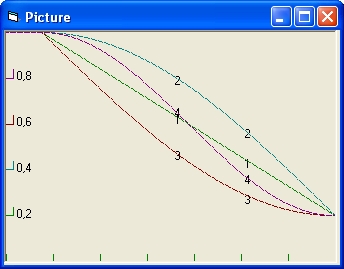
- The following display shows the results for the test 1,2,3 and 4 in that order

Test Rad Vis SP vel height mass mass mass density density galaxy velocity disk bulge disk total bulge disk 1 50000 200 2000 0,423 1,795 2,218 0,0120 0,0107 2 70000 200 2000 0,420 2,648 3,069 0,0119 0,0111 3 70000 250 2000 0,652 4,105 4,757 0,0185 0,0173 4 50000 250 2000 0,655 2,278 3,436 0,0185 0,0165 - The following display shows the results for the test 2,5 and 6 in that order
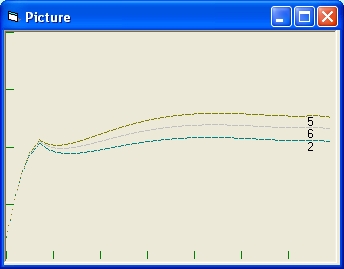
Test SP vel height Density mass mass mass density density cali velocity disk correction bulge disk total bulge disk bration 2 200 2000 0,8 0,420 2,648 3,069 0,0119 0,0111 1 5 233,3 3000 0,8 0,420 3,973 4,393 0,0119 0,0111 0 6 218,4 2000 1,0 0,420 3,311 3,731 0,0119 0,0139 0 - The following display shows the results for the test 7,8 and 9 in that order
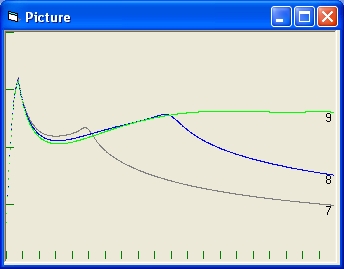
Test SP vel radius Density mass mass mass density density cali velocity vis gal correction bulge disk total bulge disk bration 7 220 50000 0,18 1,143 1,561 2,705 0,0323 0,0059 1 8 214,7,3 100000 0,18 1,135 4,928 6,064 0,0321 0,0061 0 9 209,4 200000 0,18 1,118 12,068 13,187 0,0317 0,0066 0 - The following display shows the results for the test 2,10 and 11 in that order
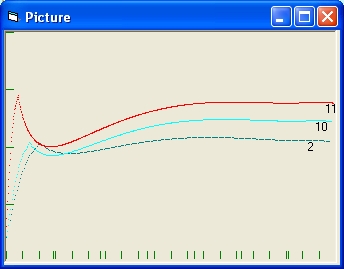
Test Rad vis Rad tot SP height Density mass mass mass density density galaxy galaxy velocity disk correction bulge disk total bulge disk 2 70000 70000 200 2000 0,8 0,420 2,648 3,069 0,0119 0,0111 10 100000 100000 200 2000 0,8 0,432 5,3793 5,8118 0,0123 0,0114 11 200000 200000 200 1000 0,5 0,924 13,858 14,783 0,0262 0,0152 - The following display shows the results for the test 12 and 13 in that order
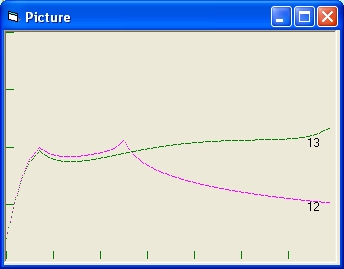
Test Rad Vis SP vel height mass mass mass density density cali galaxy velocity disk bulge disk total bulge disk bration 12 26000 200 2000 0,381 0,627 1,0089 0,0108 0,0089 1 13 70000 187,1 2000 0,374 2,727 3,101 0,0106 0,0095 0 Test 12 and Test 13 are used to demonstrate the importance of the disk size i.e. the parameters Radius Visible galaxy and Radius Total galaxy. Specific the influence of mass outside the visible range.
- Test 12 is the target test. The parameter Radius Visible galaxy = 26000 and is much shorter as the parameter Radius Total galaxy. Calabration = 1
- Test 13 is the chalenge test. The parameter Radius Visible galaxy is much larger and equal to the parameter Radius Total galaxy. Calibration = 0
What the chalenge test shows that the mass outside R = 26000 influences the Galaxy Rotation Curve before R 26000.
- The following display shows the results for the test 14 and 15 in that order
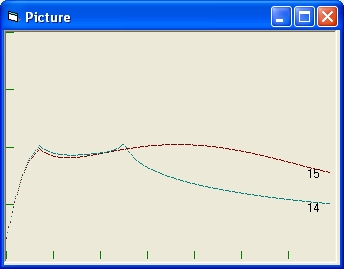
Test Rad Vis SP vel height mass mass mass density density cali galaxy velocity disk bulge disk total bulge disk bration 14 26000 200 2000 0,388 0,5937 0,9824 0,0110 0,0092 1 15 70000 194,6 2000 0,381 1,644 2,026 0,0108 0,0115 0 Test 14 and Test 15 are used to demonstrate the importance of the disk size and shape i.e. the parameters Radius Visible galaxy , Radius Total galaxy and shape disk . Specific the influence of mass outside the visible range.
- Test 14 is the target test. The parameter Radius Visible galaxy = 26000 and is much shorter as the parameter Radius Total galaxy. Calabration = 1
- Test 15 is the chalenge test. The parameter Radius Visible galaxy is much larger and equal to the parameter Radius Total galaxy. Calibration = 0
What the chalenge test shows that the mass outside R = 26000 influences the Galaxy Rotation Curve before R 26000.The difference between the Tests (12,13) and the Tests (14,15) is the parameter and shape disk.
- In the tests 12 and 13 the parameter shape disk is 0,3 . That means at the end of the disk the height of the disk is 0.3 * 2000. That means there is more mass outside this range.
- In the tests 12 and 13 the parameter shape disk is 0. That means at the end of the disk the height of the disk is 0.